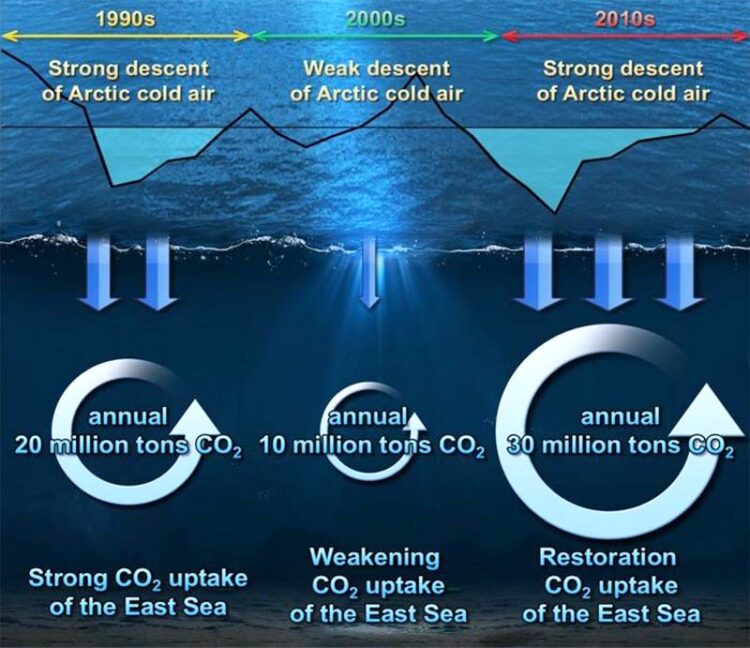Arctic cold snap transforms into a blessing

Variations in carbon dioxide absorption in the East Sea due to the southward movement of Arctic air
Credit: POSTECH
The recent cold spell has plunged the nation into a deep freeze, resulting in the closure of 247 national parks, the cancellation of 14 domestic flights, and the scrapping of 107 cruise ship voyages. While the cold snap brought relief by significantly reducing the prevalence of particulate matter obscuring our surroundings, a recent study indicates that, besides diminishing particulate matter, it is significantly contributing to the heightened uptake of carbon dioxide by the East Sea.
According to research conducted by a team of researchers including Professor Kitack Lee from the Division of Environmental Science & Engineering at Pohang University of Science and Technology (POSTECH), and Professor Tongsup Lee and So-Yun Kim from the Department of Oceanography at Pusan National University, the cold atmosphere in the Arctic is influencing the absorption of carbon dioxide by the East Sea. The research findings were published in Geophysical Research Letters, an international journal by the American Geophysical Union (AGU).
The research team investigated the correlation between the East Sea’s surface-deep circulation and its carbon dioxide absorption capacity, drawing insights from observations in 1992, 1999, 2007, and 2019. During the initial period (1992-1999), the ocean absorbed 20 million tons of carbon dioxide annually. In the subsequent period (1999-2007), this amount decreased to under 10 million tons per year. However, in the final period (2007-2019), the carbon dioxide uptake surged to 30 million tons per year.
The team observed that the internal circulation along the East Coast within the East Sea was influenced by the Arctic cold wave. Cold air from the Arctic infiltrates the East Sea, causing the surface water, laden with carbon dioxide, to become denser. This process induces vertical ventilation as the water descends into the middle and deep ocean layers. Consequently, the intensified descent of cold air from the Arctic strengthens the internal circulation, leading to a heightened uptake of carbon dioxide in the East Sea.
Professor Kitack Lee who led the research remarked, ” The oceans represent an immense reservoir of carbon dioxide and offer a secure and sustainable avenue for mitigating atmospheric carbon dioxide levels.” He further stated, “It is crucial to anticipate the global ocean’s capacity for carbon removal as we navigate future climate changes and identify suitable methods to leverage this potential.”
In a related development, the team’s earlier research uncovered the mechanism through which the ocean absorbs carbon dioxide. Approximately half of the carbon dioxide generated by human activities remains in the atmosphere with the other half entering marine and terrestrial ecosystems. With a carbon content 400,000 times greater than that of the atmosphere, the oceans present vast and promising potential for storing carbon dioxide.
The research was sponsored by the Ocean, Land, and Atmosphere Carbon Cycle System Research Program of the National Research Foundation of Korea and a research contract program of the National Institute of Fisheries Sciences of Korea.
Journal: Geophysical Research Letters
DOI: 10.1029/2023GL105819
Article Title: Climate-Driven Fluctuations in Anthropogenic CO2 Uptake by the East Sea in the North Pacific Ocean
Article Publication Date: 7-Nov-2023
Media Contact
Jinyoung Huh
Pohang University of Science & Technology (POSTECH)
jyhuh@postech.ac.kr
Office: 82-54-279-2415
All latest news from the category: Earth Sciences
Earth Sciences (also referred to as Geosciences), which deals with basic issues surrounding our planet, plays a vital role in the area of energy and raw materials supply.
Earth Sciences comprises subjects such as geology, geography, geological informatics, paleontology, mineralogy, petrography, crystallography, geophysics, geodesy, glaciology, cartography, photogrammetry, meteorology and seismology, early-warning systems, earthquake research and polar research.
Newest articles

Silicon Carbide Innovation Alliance to drive industrial-scale semiconductor work
Known for its ability to withstand extreme environments and high voltages, silicon carbide (SiC) is a semiconducting material made up of silicon and carbon atoms arranged into crystals that is…

New SPECT/CT technique shows impressive biomarker identification
…offers increased access for prostate cancer patients. A novel SPECT/CT acquisition method can accurately detect radiopharmaceutical biodistribution in a convenient manner for prostate cancer patients, opening the door for more…

How 3D printers can give robots a soft touch
Soft skin coverings and touch sensors have emerged as a promising feature for robots that are both safer and more intuitive for human interaction, but they are expensive and difficult…




















